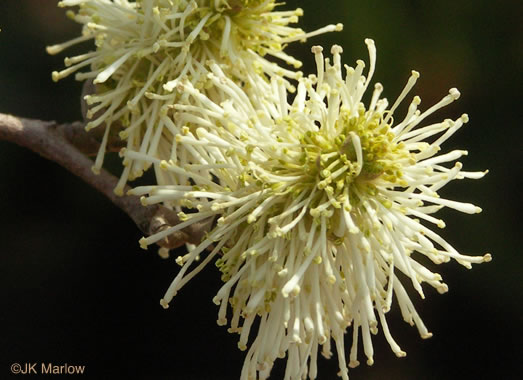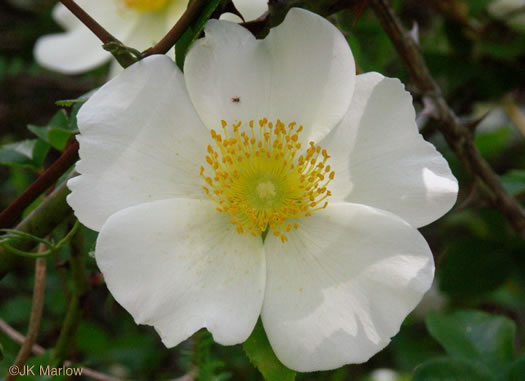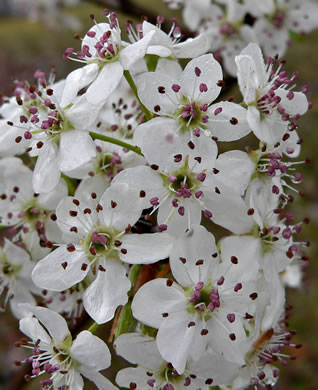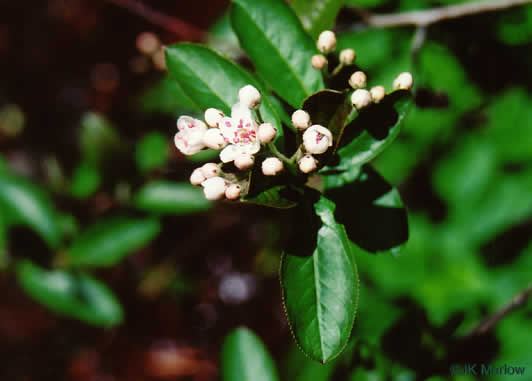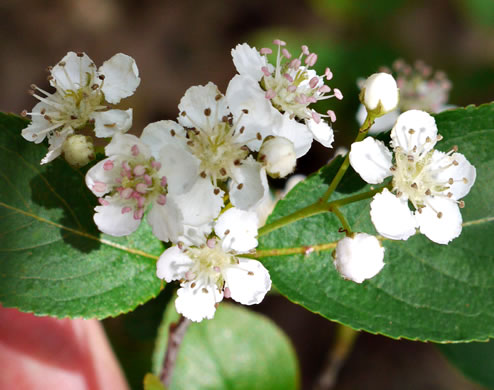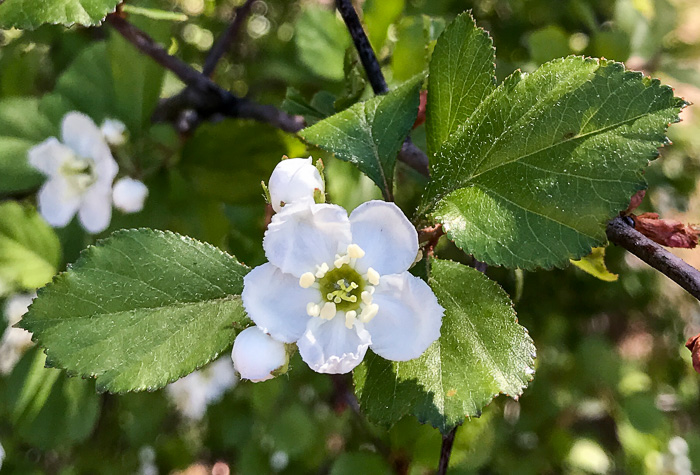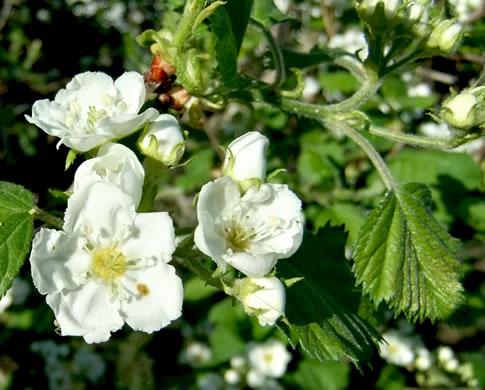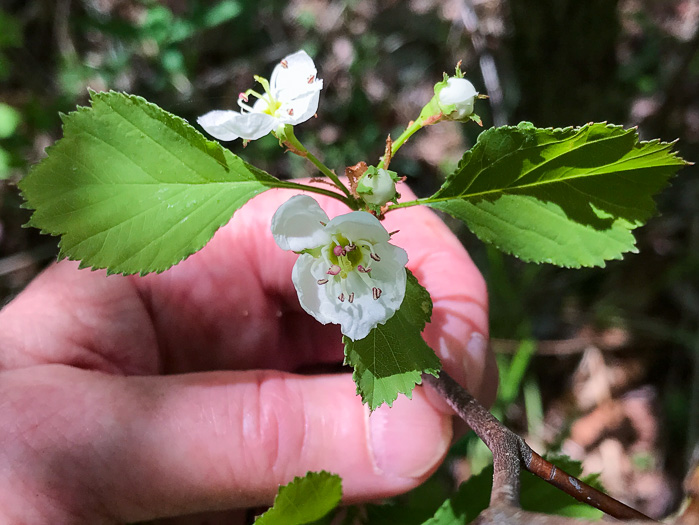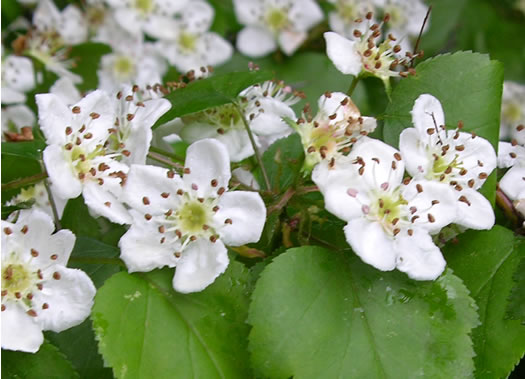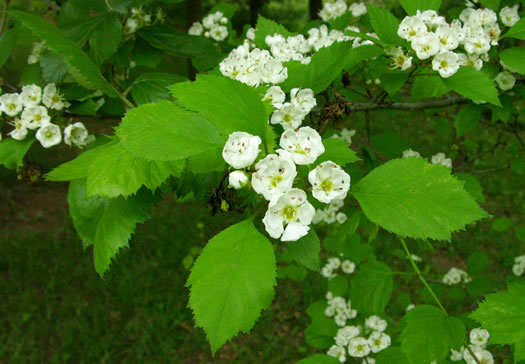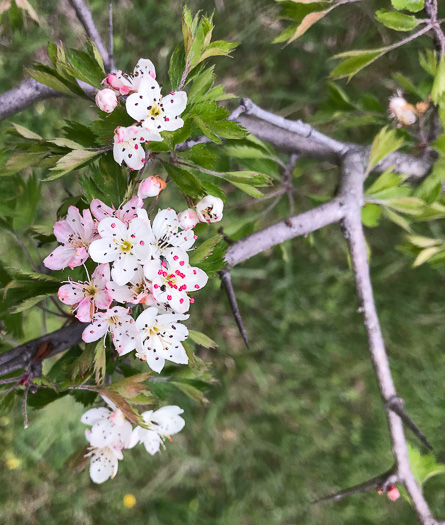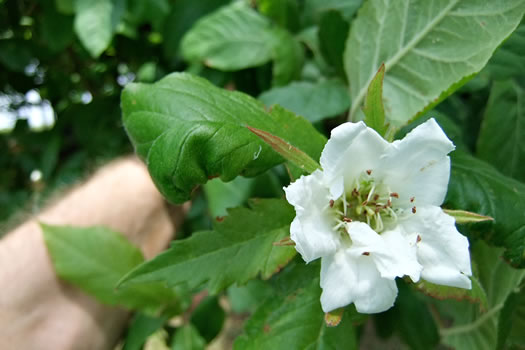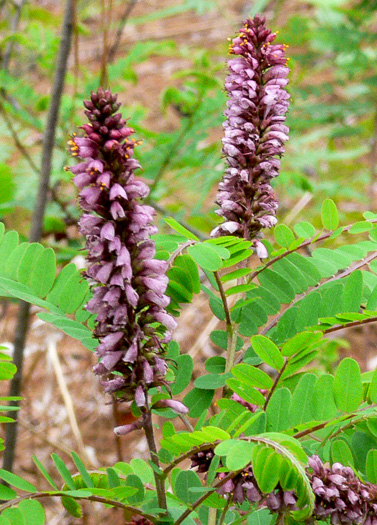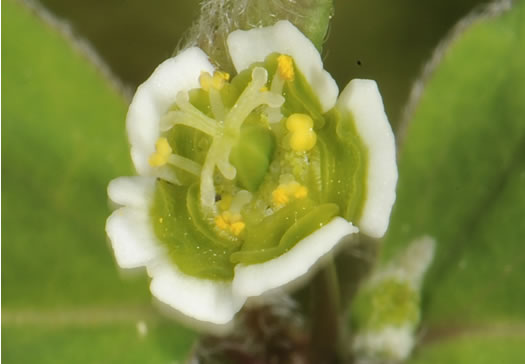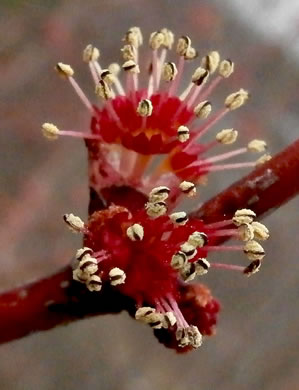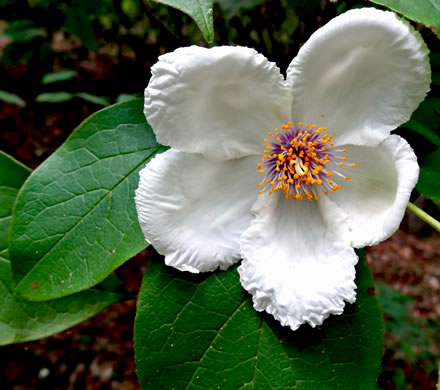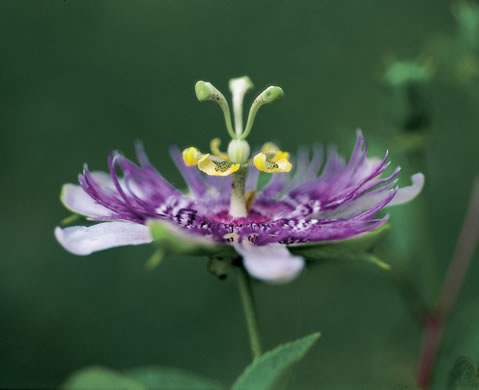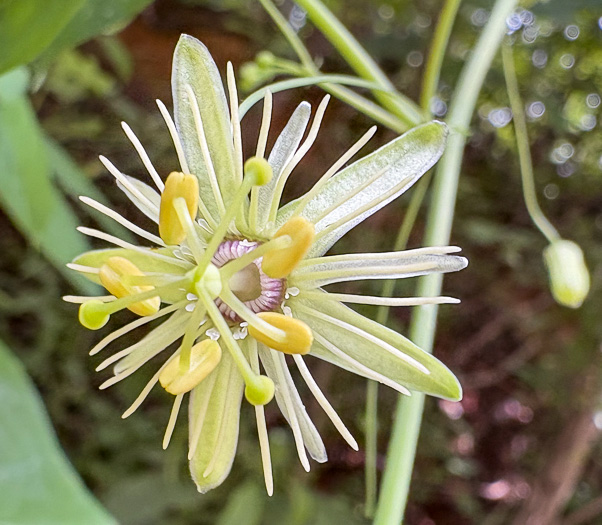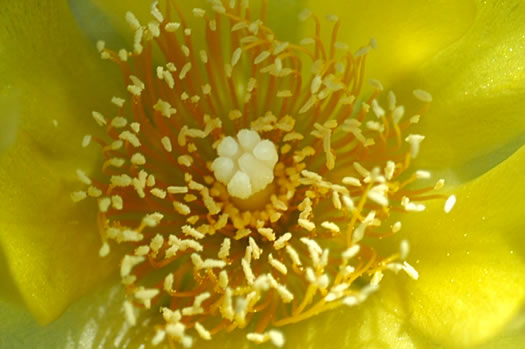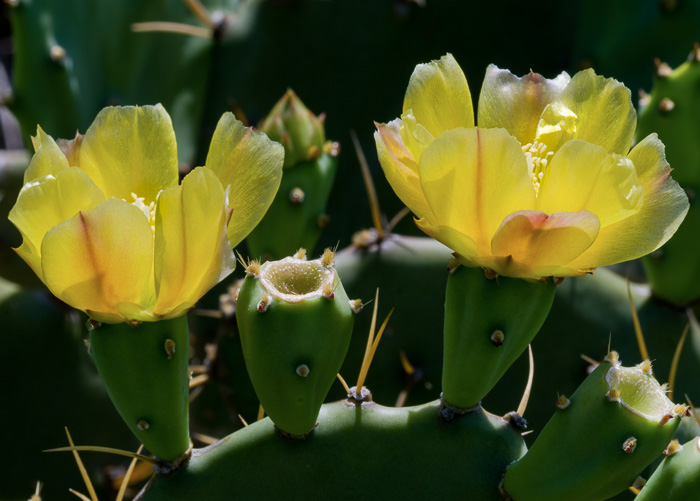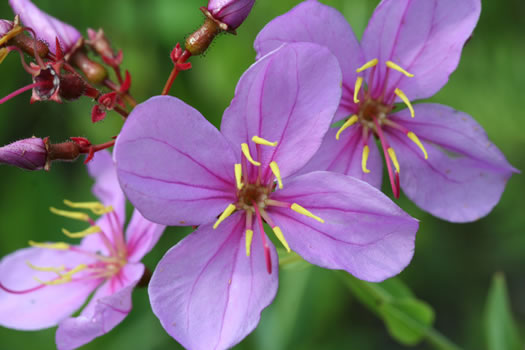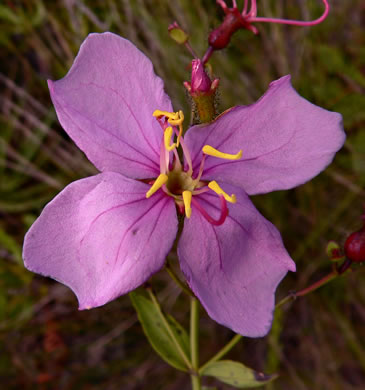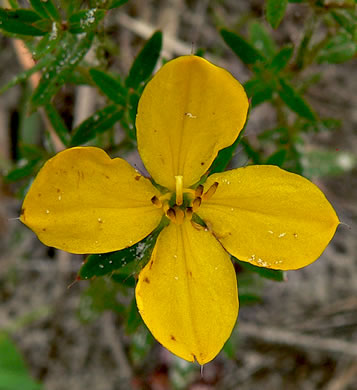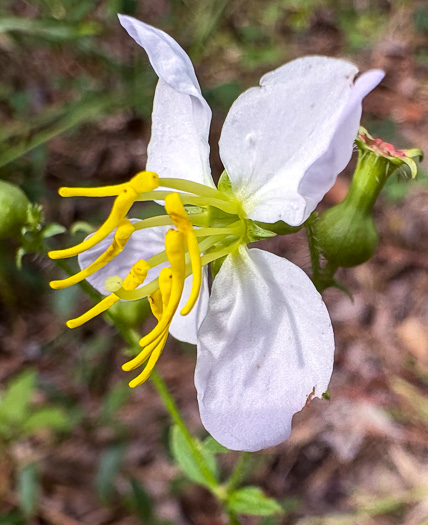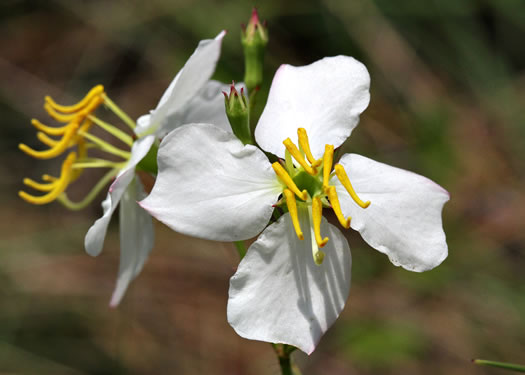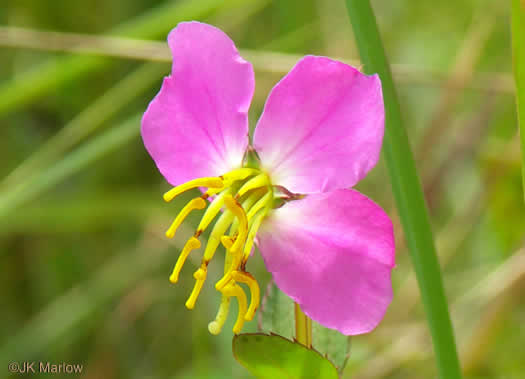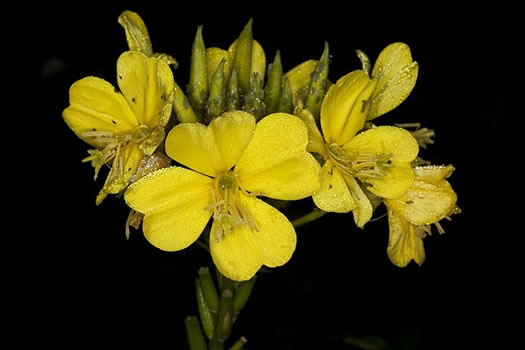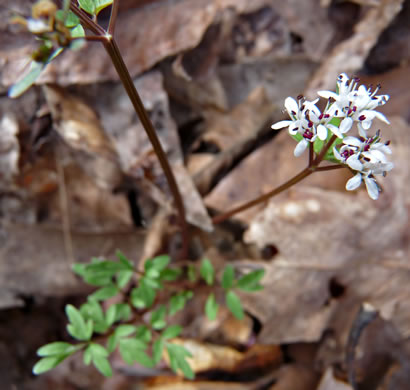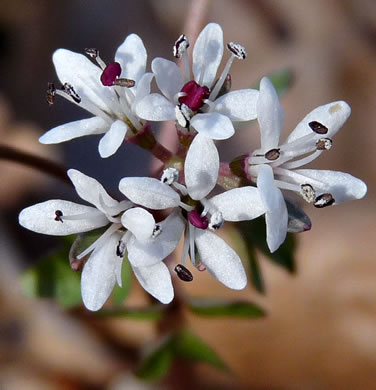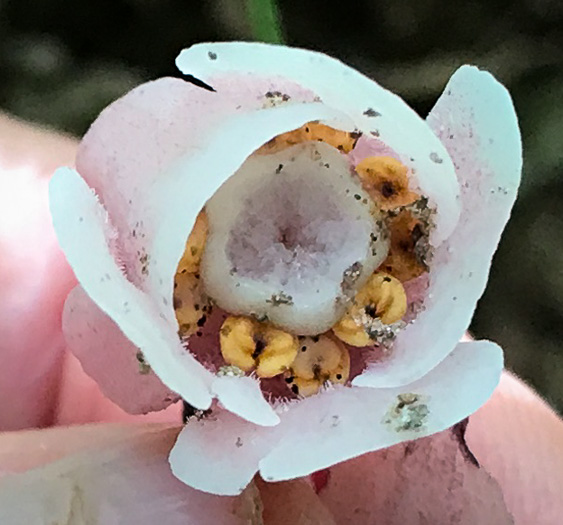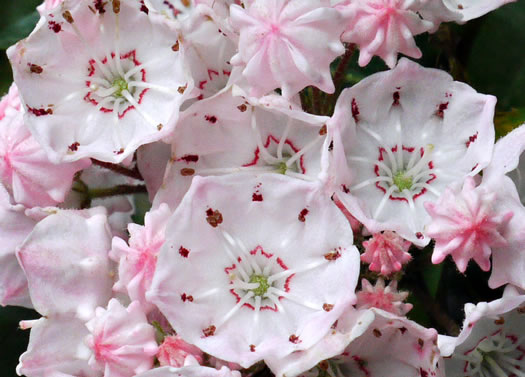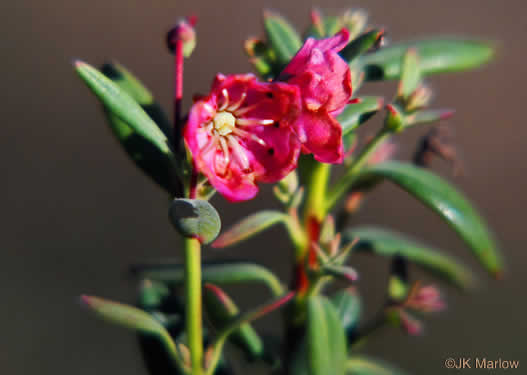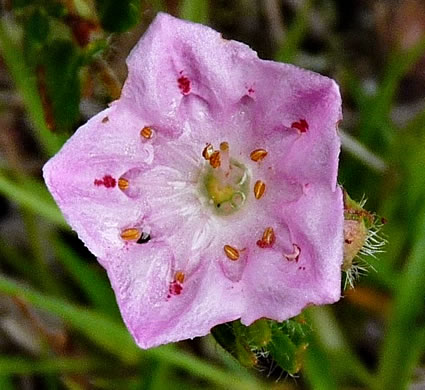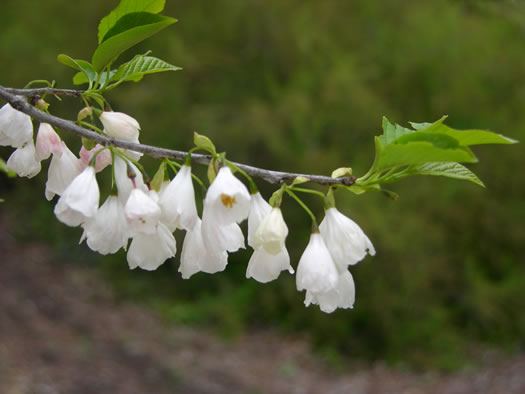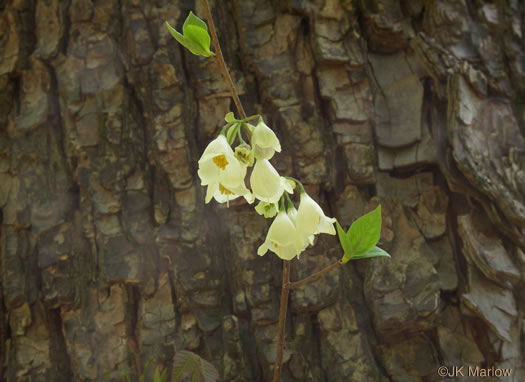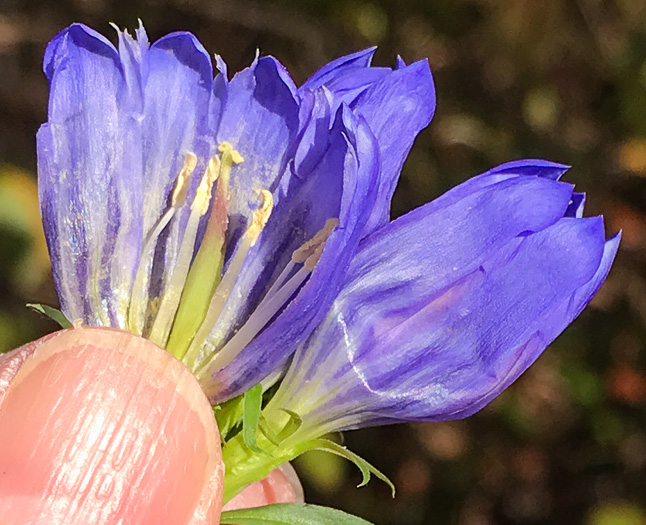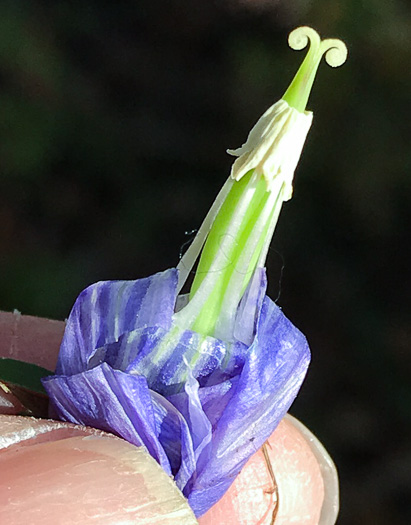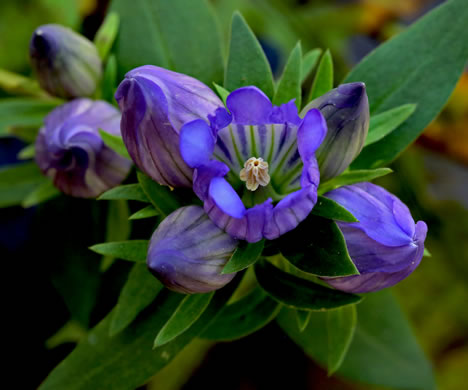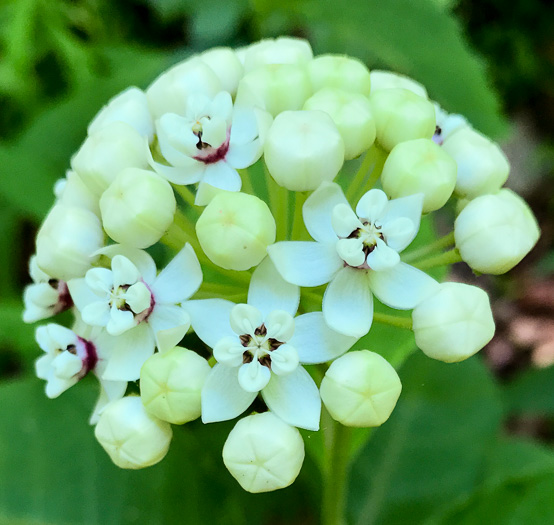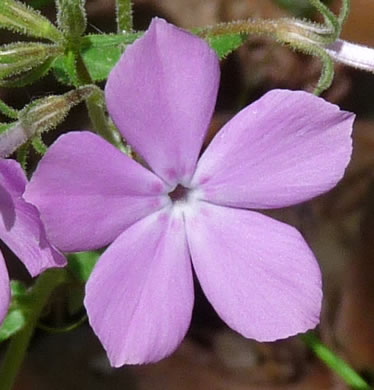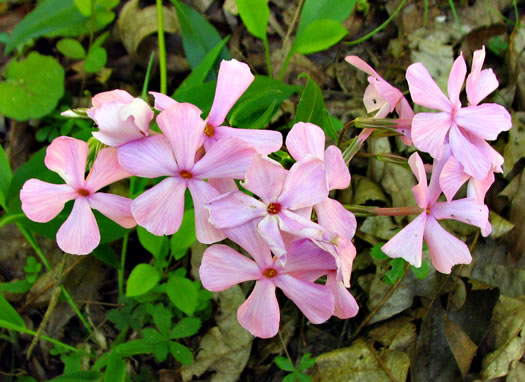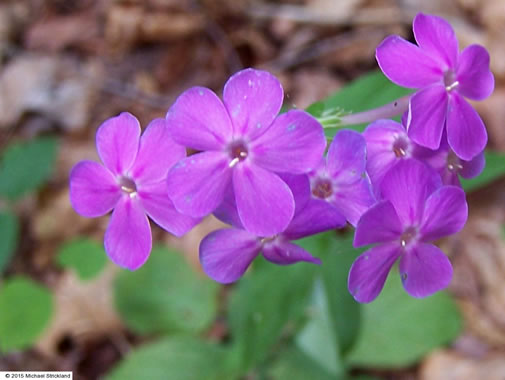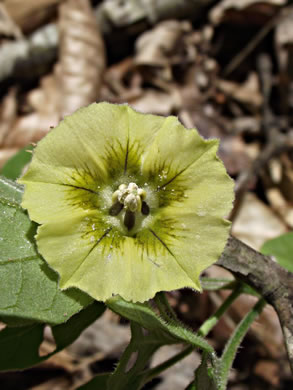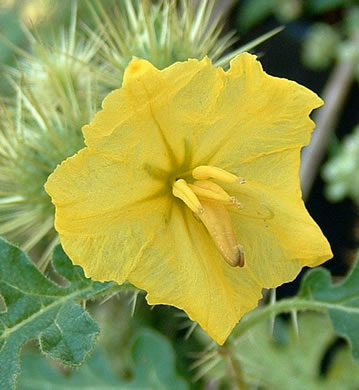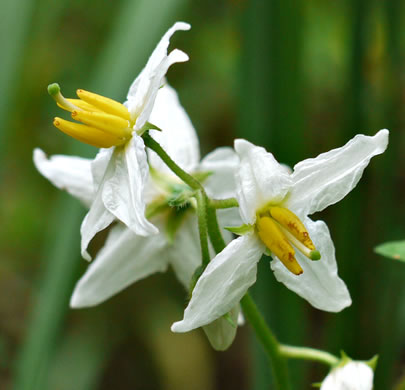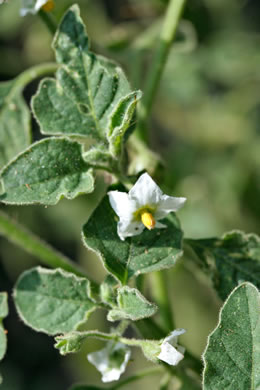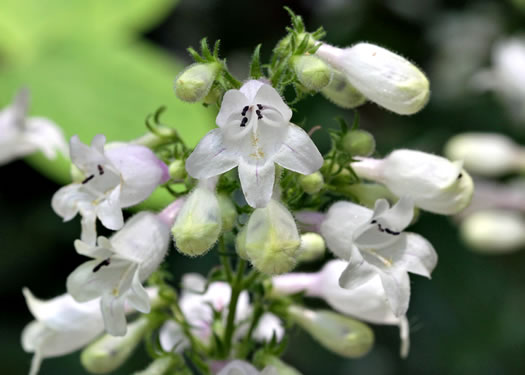Your search found 141 image(s) illustrating the term "anther." For a written explanation, click on "anther" in the Glossary.
To see larger pictures, click or hover over the thumbnails.
To go to the plant's detail page, click its name.
 Coastal Witch-alder,
Fothergilla gardenii
Coastal Witch-alder,
Fothergilla gardenii
1-2" spikes of white stamens & yellow anthers form little bottlebrushes, per Gardening with the Native Plants of Tennessee (Hunter, 2002).
 Cherokee Rose,
Rosa laevigata
Cherokee Rose,
Rosa laevigata
Five broad 1-1.5" petals subtend a mass of golden yellow anthers, per Atlantic Coastal Plain Wildflowers (Nelson, 2006).
 Bradford Pear,
Pyrus calleryana
Bradford Pear,
Pyrus calleryana
Large clusters of brilliantly white flowers with maroon-tipped anthers, per A Field Guide for the Identification of Invasive Plants in Southern Forests (Miller, Chambliss, & Lowenstein, 2010).
 Red Chokeberry,
Aronia arbutifolia
Red Chokeberry,
Aronia arbutifolia
Petals w crinkly margins subtend stamens tipped w pinkish-red anthers, per Atlantic Coastal Plain Wildflowers (Nelson, 2006).
 Purple Chokeberry,
Aronia prunifolia
Purple Chokeberry,
Aronia prunifolia
Petals white, anthers pinkish-red.
 Black Chokeberry,
Aronia melanocarpa
Black Chokeberry,
Aronia melanocarpa
Flat-topped clusters of wonderfully fragrant flowers sporting red anthers, per Gardening with the Native Plants of Tennessee (Hunter, 2002).
 Sunny Hawthorn,
Crataegus aprica
Sunny Hawthorn,
Crataegus aprica
Stamens ten, anthers white, per Haws: A Guide to Hawthorns of the Southeastern US (Lance, 2014).
 Valley Head Hawthorn,
Crataegus ignava
Valley Head Hawthorn,
Crataegus ignava
Inflorescences are glabrate; stamens 15-20; anthers pink to rose, per Weakley's Flora (2020).
 Woolly Hawthorn,
Crataegus mollis var. lanuginosa
Woolly Hawthorn,
Crataegus mollis var. lanuginosa
Anthers somewhat smaller than in normal mollis, and vary in color from rose to near white, per Haws: A Guide to Hawthorns of the Southeastern US (Lance, 2014).
 Downy Hawthorn,
Crataegus mollis var. mollis
Downy Hawthorn,
Crataegus mollis var. mollis
Anthers white, rarely light pink, per Haws: A Guide to Hawthorns of the Southeastern US (Lance, 2014).
 Buckley's Hawthorn,
Crataegus buckleyi
Buckley's Hawthorn,
Crataegus buckleyi
About 10 stamens per flower, anthers pink or rose, per Haws: A Guide to Hawthorns of the Southeastern US (Lance, 2014).
 Gattinger's Hawthorn,
Crataegus pruinosa var. gattingeri
Gattinger's Hawthorn,
Crataegus pruinosa var. gattingeri
Anthers smaller than those of the typical variety of C. pruinosa, per Haws: A Guide to Hawthorns of the Southeastern US (Lance, 2014).
 Entangled Hawthorn,
Crataegus intricata var. intricata
Entangled Hawthorn,
Crataegus intricata var. intricata
Basic defining characters include 10 stamens and pale anthers, per Weakley's Flora (2020).
 Parsley Hawthorn,
Crataegus marshallii
Parsley Hawthorn,
Crataegus marshallii
Infl. 3-12 flowered; flowers 6-10mm wide, anthers red; flowering when leaves about half-grown, per Haws: A Guide to Hawthorns of the Southeastern US (Lance, 2014).
 European Medlar,
Crataegus germanica
European Medlar,
Crataegus germanica
Flowers 3-5cm wide, petals notched; anthers reddish, per Haws: A Guide to Hawthorns of the Southeastern US (Lance, 2014).
 Mimosa Vine,
Mimosa strigillosa
Mimosa Vine,
Mimosa strigillosa
Pink to purple filaments long exserted, each terminated by a yellow anther, per Mimosa strigillosa (Mimosaceae) in Illinois (Basinger, 2003).
 Georgia Indigo-bush,
Amorpha georgiana
Georgia Indigo-bush,
Amorpha georgiana
Flowers pea-shaped, bluish-violet or reddish violet, anthers golden yellow, per Wildflowers of the Sandhills Region (Sorrie, 2011).
 Dove's-foot Cranesbill,
Geranium molle
Dove's-foot Cranesbill,
Geranium molle
All 10 stamens are fertile, but anthers may fall readily, per Weakley's Flora.
 Cumberland Spurge,
Euphorbia mercurialina
Cumberland Spurge,
Euphorbia mercurialina
Several staminate flowers with yellow anthers & solitary pistillate flower, per Wildflowers of Tennessee, the Ohio Valley, and the Southern Appalachians (Horn, Cathcart, Hemmerly, & Duhl, 2005).
 Eastern Red Maple,
Acer rubrum var. rubrum
Eastern Red Maple,
Acer rubrum var. rubrum
Perianth usually red, 1-3mm long. Anthers 1.5-2mm long, filaments erect, per Vascular Flora of the Carolinas (Radford, Ahles, & Bell, 1968).
 Mountain Camellia,
Stewartia ovata
Mountain Camellia,
Stewartia ovata
The numerous stamens have yellow anthers and the 5 styles are separate, per Native Trees of the Southeast, An Identification Guide (Kirkman, Brown, & Leopold, 2007).
 Purple Passionflower,
Passiflora incarnata
Purple Passionflower,
Passiflora incarnata
Yellowish anthers circle below 3 arching styles and enlarged stigmas, per Wildflowers of Tennessee, the Ohio Valley, and the Southern Appalachians (Horn, Cathcart, Hemmerly, & Duhl, 2005).
 Yellow Passionflower,
Passiflora lutea
Yellow Passionflower,
Passiflora lutea
5 slender petals, 5 greenish sepals, 5 pale yellowish anthers and 3 long green styles, per Wildflowers of Tennessee, the Ohio Valley, and the Southern Appalachians (Horn, Cathcart, Hemmerly, & Duhl, 2005).
 Eastern Prickly-pear,
Opuntia mesacantha ssp. mesacantha
Eastern Prickly-pear,
Opuntia mesacantha ssp. mesacantha
Anthers pale yellow to cream; style and stigma lobes white, per Flora of North America.
 Dune Prickly-pear,
Opuntia drummondii
Dune Prickly-pear,
Opuntia drummondii
Inner tepals yellow throughout; filaments & anthers yellow; stigma lobes white, per Flora of North America.
 Coastal Prickly-pear,
Opuntia stricta var. dillenii
Coastal Prickly-pear,
Opuntia stricta var. dillenii
Inner tepals light yellow throughout; filaments, anthers style & stigma yellow, per Flora of North America.
 Coastal Prickly-pear,
Opuntia stricta var. stricta
Coastal Prickly-pear,
Opuntia stricta var. stricta
Inner tepals light yellow throughout; filaments, anthers style & stigma yellow, per Flora of North America.
 Ciliate Meadowbeauty,
Rhexia petiolata
Ciliate Meadowbeauty,
Rhexia petiolata
Anthers straight to slightly curved, usually shorter than the filaments, per Weakley's Flora (2012).
 Smooth Meadowbeauty,
Rhexia alifanus
Smooth Meadowbeauty,
Rhexia alifanus
Petals mostly 1"; 8 conspicuous stamens terminated by bright yellow anthers, per Atlantic Coastal Plain Wildflowers (Nelson, 2006).
 Smooth Meadowbeauty,
Rhexia alifanus
Smooth Meadowbeauty,
Rhexia alifanus
Anthers 5-11mm long, distinctly curved, per Weakley's Flora (2012).
 Yellow Meadowbeauty,
Rhexia lutea
Yellow Meadowbeauty,
Rhexia lutea
Petals obovate to broadly elliptical, each petal oblique. Anthers straight, per Wildflowers of the Sandhills Region (Sorrie, 2011).
 Pale Meadowbeauty,
Rhexia mariana var. mariana
Pale Meadowbeauty,
Rhexia mariana var. mariana
Petals pale pink (to white); stamens 8, with prominent curved yellow anthers, per Wildflowers of Tennessee (Carman, 2005).
 White Meadowbeauty,
Rhexia mariana var. exalbida
White Meadowbeauty,
Rhexia mariana var. exalbida
The white flowers and linear leaves are diagnostic. Anthers distinctly curved, per Weakley's Flora (2022).
 Virginia Meadowbeauty,
Rhexia virginica
Virginia Meadowbeauty,
Rhexia virginica
Magenta to deep-rose petals & 8 stamens w long curved, bright yellow anthers, per Wildflowers of the Southern Mountains (Smith, 1998).
 Common Evening-primrose,
Oenothera biennis
Common Evening-primrose,
Oenothera biennis
Four broad yellow petals with notched tips. Yellow anthers extended, per Forest Plants of the Southeast and Their Wildlife Uses (Miller & Miller, 2005).
 Harbinger-of-Spring,
Erigenia bulbosa
Harbinger-of-Spring,
Erigenia bulbosa
Anthers are purplish-brown, per Wildflowers of Tennessee, the Ohio Valley, and the Southern Appalachians (Horn, Cathcart, Hemmerly, & Duhl, 2005).
 Harbinger-of-Spring,
Erigenia bulbosa
Harbinger-of-Spring,
Erigenia bulbosa
Black of anthers & white of petals give plant a "pepper & salt" appearance, per www.missouriplants.com
 Pipsissewa,
Chimaphila maculata
Pipsissewa,
Chimaphila maculata
Filaments very short; anthers bifurcated, releasing pollen from round pores at their tips, per www.illinoiswildflowers.info.
 Pipsissewa,
Chimaphila maculata
Pipsissewa,
Chimaphila maculata
10 stamens each with a pair of conspicuous tubular anthers, per Wildflowers of the Southern Mountains (Smith, 1998).
 Indian Pipes,
Monotropa uniflora
Indian Pipes,
Monotropa uniflora
Stamens included; anthers horizontal at anthesis. Stigma broadly funnelform, per Flora of North America.
 Mountain Laurel,
Kalmia latifolia
Mountain Laurel,
Kalmia latifolia
Usually with purple around the 10 pockets in which the anthers are fitted, per Guide to the Wildflowers of SC, 1st ed. (Porcher & Rayner, 2001).
 Southern Sheepkill,
Kalmia carolina
Southern Sheepkill,
Kalmia carolina
The anthers are tucked into pockets and pop out when touched by insects, per Guide to the Wildflowers of SC, 1st ed. (Porcher & Rayner, 2001).
 Hairy Wicky,
Kalmia hirsuta
Hairy Wicky,
Kalmia hirsuta
The stamens are curved backwards, their anthers lodged in pockets, per Atlantic Coastal Plain Wildflowers (Nelson, 2006).
 Sandhills Pyxie-moss,
Pyxidanthera barbulata var. brevifolia
Sandhills Pyxie-moss,
Pyxidanthera barbulata var. brevifolia
The Greek "pixie" means "small box" and "anthera" means "anther", per Guide to the Wildflowers of SC, 1st ed. (Porcher & Rayner, 2001).
 Common Silverbell,
Halesia tetraptera var. tetraptera
Common Silverbell,
Halesia tetraptera var. tetraptera
Anthers just within the mouth of corolla tube, style slightly exserted, per Weakley's Flora (2008).
 Mountain Silverbell,
Halesia tetraptera var. monticola
Mountain Silverbell,
Halesia tetraptera var. monticola
Anthers well inside the mouth of the corolla tube, per Weakley's Flora (2008).
 Soapwort Gentian,
Gentiana saponaria
Soapwort Gentian,
Gentiana saponaria
These anthers weren't fused together like those of other nearby plants. Wonder why - is it timing?
 Soapwort Gentian,
Gentiana saponaria
Soapwort Gentian,
Gentiana saponaria
Anthers connate at anthesis, per Weakley's Flora (2022).
 Coastal Plain Gentian,
Gentiana catesbyi
Coastal Plain Gentian,
Gentiana catesbyi
Though technically bisexual, gentians develop mature pollen-bearing anthers...
 White Milkweed,
Asclepias variegata
White Milkweed,
Asclepias variegata
Each flower white, a purple ring surrounding the fused anthers and style, per Wildflowers of the Atlantic Southeast (Cotterman, Waitt, & Weakley, 2019).
 Downy Phlox,
Phlox pilosa ssp. pilosa
Downy Phlox,
Phlox pilosa ssp. pilosa
Anthers remain inside the flower tube and are not visible upon flowering, per Wildflowers of Tennessee, the Ohio Valley, and the Southern Appalachians (Horn, Cathcart, Hemmerly, & Duhl, 2005).
 Creeping Phlox,
Phlox stolonifera
Creeping Phlox,
Phlox stolonifera
Anthers & style show at the end of corolla tube, per Wildflowers of Tennessee, the Ohio Valley, and the Southern Appalachians (Horn, Cathcart, Hemmerly, & Duhl, 2005).
 Mountain Phlox,
Phlox ovata
Mountain Phlox,
Phlox ovata
Style is long; anthers and style are visible at the apex of corolla tube, per Wildflowers of Tennessee, the Ohio Valley, and the Southern Appalachians (Horn, Cathcart, Hemmerly, & Duhl, 2005).
 Smooth Phlox,
Phlox glaberrima
Smooth Phlox,
Phlox glaberrima
Anthers and style show at the end of the corolla tube, per Wildflowers of Tennessee, the Ohio Valley, and the Southern Appalachians (Horn, Cathcart, Hemmerly, & Duhl, 2005).
 Dune Ground-cherry,
Physalis walteri
Dune Ground-cherry,
Physalis walteri
Corolla may or may not have dark spots in the base of the tube. Anthers yellow, per Vascular Flora of the Carolinas (Radford, Ahles, & Bell, 1968).
 Virginia Ground-cherry,
Physalis virginiana
Virginia Ground-cherry,
Physalis virginiana
Flower yellow with brown spots in the center and yellow anthers, per Wildflowers of Tennessee, the Ohio Valley, and the Southern Appalachians (Horn, Cathcart, Hemmerly, & Duhl, 2005).
 Buffalo-bur Nightshade,
Solanum rostratum
Buffalo-bur Nightshade,
Solanum rostratum
Corolla yellow, 16-24mm broad. Anthers spreading, unequal, lowermost longest, per Vascular Flora of the Carolinas (Radford, Ahles, & Bell, 1968).
 Carolina Horsenettle,
Solanum carolinense var. carolinense
Carolina Horsenettle,
Solanum carolinense var. carolinense
5-lobed, pale violet to white flowers, ~ 3/4" wide; yellow anthers prominent, per Wildflowers of Tennessee (Carman, 2005).
 Hairy Nightshade,
Solanum sarrachoides
Hairy Nightshade,
Solanum sarrachoides
Corolla white, 7-11mm broad, the lobes spreading, anthers connivent, per Vascular Flora of the Carolinas (Radford, Ahles, & Bell, 1968).
 Foxglove Beardtongue,
Penstemon digitalis
Foxglove Beardtongue,
Penstemon digitalis
The floral tube flares abruptly; the 4 functional anthers are dark brown, per All About South Carolina Wildflowers (Midgley, 1999).

